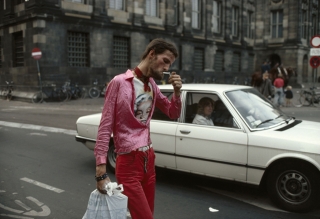Ed van der Elsken
1925
Eduard (Ed) van der Elsken was born in Amsterdam on 10 March.
1943
Followed for one year a course in sculpture at the Institute for Applied Art Education (IVKO) in Amsterdam, but was forced to leave the school by the German occupation.
1944-1945
Spent the final year of the war hidden underground in the South of Holland, to avoid the German call-up. Joined the allied liberation troops after the Battle of Arnhem.
1945-1947
Following a preparatory course as filmoperator. Decided to become a photographer and followed a correspondence course with the School of Professional Photography in The Hague, but failed the exams.
1947-1950
Made his first street photographs in Amsterdam with his father's 9 x 12″ plate camera. Acquired experience working for various other photographers and made photographs during his first trip abroad. His photographs of Paris and Marseille were enthusiastically received by members of the GKf, the most important post-war organization for photographers in The Netherlands.
1950
Received a letter of introduction from Kryn Taconis, a photographer who was also a member of the GKf, to Pierre Gassman, Director of Pictorial Service, the photo laboratory of the Magnum photographers in Paris. After a couple of months of working in the darkroom, he left the job to resume taking his own pictures.
1950-1954
Became associated with a group of young people who spent their time mainly in cafés around Saint-Germain-des-Prés. The photographs of these bohemiens resulted in his autobiographical-tinted pictorial novel Love on the Left Bank (1956). Married in 1954 the photographer Ata Kando, whom he had met at Pictorial Service. Alongside his independent photography, he had incidental assignments from clients including L'Album du Figaro.
1953
Met Edward Steichen, curator at the Museum of Modern Art in New York, who was doing the preparatory work for The Family of Man exhibition (1955). Steichen selected eighteen photographs by Van der Elsken for the exhibition Post-War European Photography which opened in May of 1953 in New York.
1955
Returned to Amsterdam and made several photographic series for the magazine Vrij Nederland including reports on the ruffians in Amsterdam and on the painter Karel Appel. Began making films with journalist Jan Vrijman. Van der Elsken and Ata Kando were divorced in September.
1956-1957
Left for French Equatorial Africa and travelled through Ubangui Chari. His photographs would be published in the book Bagara (1958).
1959-1960
Took a fourteen month trip around the world with his second wife, Gerda van der Vee. The costs of the trip were covered by making film reports broadcast on Dutch television.
1962
Disappointed by the difficulties in publishing a book about his trip around the world, he stopped doing photography for five years, and concentrated on film like Welcome into life dear little one.
1966
His book Sweet Life was finally published and was presented during an exhibition of the same name at the Stedelijk Museum in Amsterdam, showing the work from his trip.
1966-1979
Made many travel documentaries for the magazine Avenue. For his film The Beloved Camera he received in 1971 the Dutch National Film Award. Moved to a farm in Edam in the same year. In both his still photographs and his films, country life began taking on an increasingly more important role. He also made films and documentaries abroad: in Bangladesh in 1974 and 1976. In 1977 in Pakistan, Thailand, Borneo, Bangladesh, India, Malawi, Madagascar, Brazil, Haiti and the Solomon Islands together with Anneke Hilhorst, whom he would marry in 1984. The frequent use of color in this period resulted in his first photo-book in color, Eye love you (1977).
1980-1984
The film and the book Adventures in the country were released in 1980. Made various films in the succeeding years and compiled the two books Amsterdam! Old Photo's 1947-1970 (1979) and Paris! Photo's 1950-1954 (1981).
1984-1988
Was regularly in Japan, where he had a large exhibition in Tokyo. The Dutch Ministry of Culture awarded him a grant in 1987 to complete a book on Japan. The Discovery of Japan was published in 1988. On returning from a trip to Korea which was meant to result in a book about that country, Van der Elsken heard that he was suffering from terminal cancer.
1989-1990
Following surgery, Van der Elsken still felt the urge to work and made a film about the progress of his illness. This film, Bye, was completed in 1990. Meanwhile he also worked on a book on Hong Kong, published in 1997, and on his last retrospective book of photographs, Once Upon A Time, which was released after the large retrospective photography exhibition of the same name in the Stedelijk Museum in Amsterdam in 1991. This show would travel through Europe and Japan until the end of 1994. Ed van der Elsken died on December 28 in Edam.
1991
The film Bye was shown at the Rotterdam Film Festival and on Dutch television. In Japan NHK broadcasted Bye.
Publications
Een liefdesgeschiedenis in Saint Germain des Prés 1956
Bagara (1958)
Jazz (1959)
Sweet Life (1966)
Eye Love you (1977)
Hallo! (1978)
Amsterdam! Oude foto's 1947-1970 (1979)
Avonturen op het land (1980)
Parijs! Foto's 1950-1954 (1981)
De ontdekking van Japan (1988)
L'amour!
Hong Kong (1997)
Once upon a time (1991)
Bibliography
Evelyn de Regt, 'Ed van der Elsken', in: Geschiedenis van de Nederlandse fotografie in monografieën en thema-artikelen, Alphen aan den Rijn/Amsterdam 1984-, afl. 16
Evelyn de Regt e.a., Once upon a time, Amsterdam 1991
Bas Vroege, Anneke van der Elsken-Hilhorst, Flip Bool (red.), Leve ik! Edam 1997
Exhibition catalog Ed van der Elsken: Sweet life. Fotografie + film 1949-1990, Kunstmuseum Wolfsburg, Wolfsburg 2000
Vince Aletti, Café Noir, in: Art Forum (maart) 2000
Exhibition catalog Eye love you. Ed van der Elsken Fotografies + films (1949-1990), Fundació "la Caixa", Barcelona 2001

